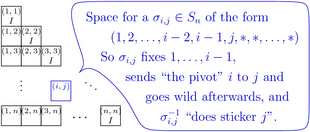11-1100/Homework Assignment 5: Difference between revisions
No edit summary |
No edit summary |
||
| Line 1: | Line 1: | ||
{{In Preparation}} |
|||
{{11-1100/Navigation}} |
{{11-1100/Navigation}} |
||
===The Final Exam=== |
|||
The Final Exam will take place on Friday December 9, 10-1 at Bahen 6183. You may expect very approximately one third of the exam to be about class-proven theorems, one third to be repeats of HW problems and/or exam problems from this year or last, and one third to be fresh exercises. You will have to solve about 5 out of about 6 problems. It is likely that the overall shape of the exam will be similar to last year's final exam, which can be found at [[10-1100/Final Exam]]. |
|||
When I was a student, before exams I usually made sure that I '''absolutely''' understand all class material and I worried less about the exercises, on the assumption that class was about the most important knowledge and that if I really understood all that was done in class, the exercises would follow relatively easily. That was my strategy; it worked well for me, but what works for you is not for me to tell. |
|||
===Last Week's Schedule=== |
===Last Week's Schedule=== |
||
<center> |
<center> |
||
Revision as of 20:16, 30 November 2011
| ||||||||||||||||||||||||||||||||||||||||||||||||||||||
The Final Exam
The Final Exam will take place on Friday December 9, 10-1 at Bahen 6183. You may expect very approximately one third of the exam to be about class-proven theorems, one third to be repeats of HW problems and/or exam problems from this year or last, and one third to be fresh exercises. You will have to solve about 5 out of about 6 problems. It is likely that the overall shape of the exam will be similar to last year's final exam, which can be found at 10-1100/Final Exam.
When I was a student, before exams I usually made sure that I absolutely understand all class material and I worried less about the exercises, on the assumption that class was about the most important knowledge and that if I really understood all that was done in class, the exercises would follow relatively easily. That was my strategy; it worked well for me, but what works for you is not for me to tell.
Last Week's Schedule
Warning. This schedule is subject to changes. Recheck this web site the day before any activity.
| Tuesday December 6 | 10-12 | Last Class |
| Wednesday December 7 | 12-2 | Dror's office hours, Bahen 6178. |
| 2PM | HW5 "early bird" due date. If you submit HW5 by this time, it will be marked by noon of the following day. | |
| Thursday December 8 | 10:30-12:30 | Dror's office hours, Bahen 6178. |
| Noon | HW5 is due in Dror's office, to be graded after the final. Also, at this time "early bird" marked HW5 can be collected at Dror's office. | |
| 3-5 | Stephen Morgan's office hours, at Huron 1028. | |
| Friday December 9 | 10-1 | The Final Exam. |
Solve the following questions
Problem 1. Let be a module over a PID . Assume that is isomorphic to , with non-zero non-units and with . Assume also that is isomorphic to , with non-zero non-units and with . Prove that , that , and that for each .
Problem 2. Let and be primes in a PID such that , let denote the operation of "multiplication by ", acting on any -module , and let and be positive integers.
- For each of the -modules , , and , determine and .
- Explain why this approach for proving the uniqueness in the structure theorem for finitely generated modules fails.
Problem 3. (comprehensive exam, 2009) Find the tensor product of the modules ("Laurent polynomials in ") and (here acts on as ).
Problem 4. (from Selick) Show that if is a PID and is a multiplicative subset of then is also a PID.
Definition. The "rank" of a module over a (commutative) domain is the maximal number of -linearly-independent elements of . (Linear dependence and independence is defined as in vector spaces).
Definition. An element of a module over a commutative domain is called a "torsion element" if there is a non-zero such that . Let denote the set of all torsion elements of . (Check that is always a submodule of , but don't bother writing this up). A module is called a "torsion module" if .
Problem 5. (Dummit and Foote, page 468) Let be a module over a commutative domain .
- Suppose that has rank and that is a maximal set of linearly independent elements of . Show that is isomorphic to and that is a torsion module.
- Converesely show that if contains a submodule which is isomorphic to for some , and so that is torsion, then the rank of is .
Problem 6. (see also Dummit and Foote, page 469) Show that the ideal in , regarded as a module over , is finitely generated but cannot be written in the form .
























![{\displaystyle {\mathbb {C} }[t]}](https://wikimedia.org/api/rest_v1/media/math/render/svg/8b320388ef42719220c79fd0800935e2d490956a)
![{\displaystyle {\mathbb {C} }[t,t^{-1}]}](https://wikimedia.org/api/rest_v1/media/math/render/svg/434476c9681bd15ca4ca484f4752703e07dd1c00)

















![{\displaystyle R={\mathbb {Z} }[x]}](https://wikimedia.org/api/rest_v1/media/math/render/svg/11975a9e1f0612ee86f0dd0c135d6255ef9a6987)
